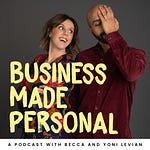One of our subscribers recently asked:
“What’s the best way to get the most out of your team members or how to develop other designers?”
We love this question because honestly? Building a strong creative team is one of the most underrated skills agency owners need to master. Whether you're working with contractors or full-time hires, the goal is the same: find great people, help them grow, and create an environment where they actually want to stay.
Here’s how we’ve done it (after plenty of trial and error).
1. Hiring the Right People Starts Way Before the First Call
Most people think hiring starts with the interview. Nope. For us, it begins the moment someone submits an application or reaches out. We immediately look for:
Responsiveness: Do they follow up in a timely way? Ghosting us for two weeks? Not a great sign.
Clarity & Communication: Are they thorough in their responses? Can they articulate their thoughts well?
Presentation: We don’t care if you don’t have a personal site—as long as you show us your best work in a thoughtful way. One of our favorite applicants sent us a personalized Loom walkthrough in Figma. Gold star.
Basically, we want to see effort, initiative, and intention.
2. In the Interview: Look for Confidence, Curiosity, and Chemistry
We don’t love the term “red flag” but let’s be real—some things are worth paying attention to:
Green Flags:
Passion for the work (“I want to work with you.”)
Openness to collaboration
Confidence in their zone of genius (e.g., “I’m great at brand identity but don’t do web.” That’s clarity, not a limitation.)
Red Flags:
Full-time job folks applying for contractor gigs and promising to “work weekends.” (No. Just no.)
Low energy, distracted, or generic “interview mode” behavior
Taking the job just for the money—not the mission
We’ve learned that you can’t coach passion or reliability. So we look for it upfront.
3. Give Them a Test (Yes, Even Contractors)
We used to feel weird about giving a paid “trial task,” but hear us out:
We asked applicants to design a podcast graphic for us—and the results were so telling. Who took the challenge seriously? Who followed direction? Who actually showed us how they think?
Some folks opted out. That’s fine. Others wowed us. Two of them are still with us over a year later.
Sometimes a simple, clear creative test is the easiest way to weed out the people who are “kinda interested” vs. truly invested.
4. Adapt to Their Working Style, But Protect Your Profit
Let’s talk logistics. Everyone works differently.
Some contractors charge hourly. Others prefer project rates. Some take more time but produce magic. Others are fast but need more oversight.
Whatever the case—make sure your business model still works.
Your goal should be:
Delegating work you don’t have time for or aren’t as skilled in
Hiring in a way that’s profitable and sustainable
Sometimes that means taking a hit to learn how someone works. But over time, you’ll build a team that aligns with your flow and your finances.
5. The Secret Sauce to Retention: Respect + Communication
Here’s where most studios drop the ball: they hire great people… and then disappear.
We make it a priority to:
Ask what kind of work they actually want to do
Give them context and briefs that get them excited
Check in during the process and offer support (not micromanagement)
Let them know they’re not on an island
We treat every contractor as a collaborative partner—not just a task rabbit.
Also: we pay fairly. We’ve even upped someone’s rate or added bonuses when we felt it was deserved (sometimes before they asked). And guess what? That always pays off.
6. Create a Culture of Growth, Not Control
The best compliment we ever got from a contractor?
“Working with you gave me the confidence to raise my rates—and start my own studio.”
That’s the goal.
If your team feels supported, challenged, respected, and appreciated, they’ll bring their best selves to your projects. And if/when they move on, they’ll be better for having worked with you—and you’ll have built a reputation as someone creatives want to work with.
That matters.
Final Thought: Check the Vibe
Not every hire is a long-term match. And that’s okay.
The first project together is the relationship tester. Does it feel easy? Is the communication flowing? Or does every task feel like pulling teeth?
Give yourself permission to not force it. Find people who are in sync with your values, your pace, and your vision.
That’s how you build a dream team—one great collaborator at a time.
If you’ve got follow-up questions or want us to dive deeper into something, hit reply or drop a comment. We’re here for it.
🧡














Share this post